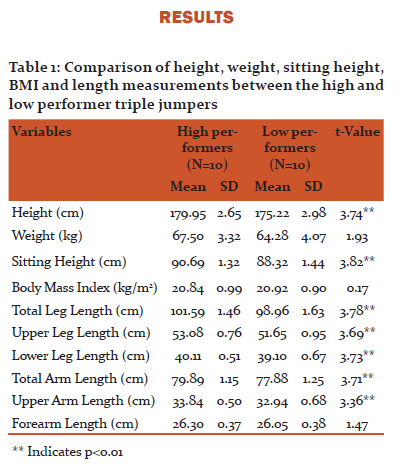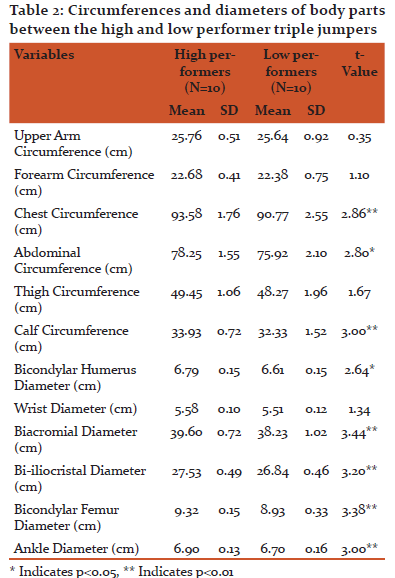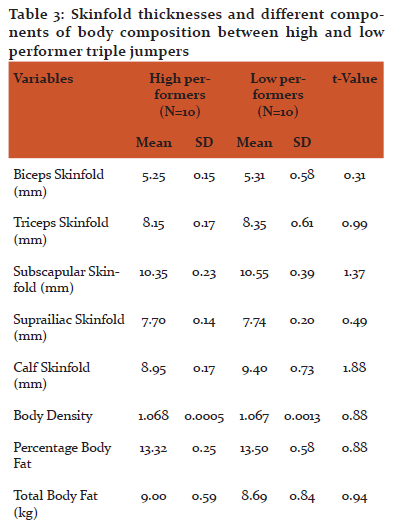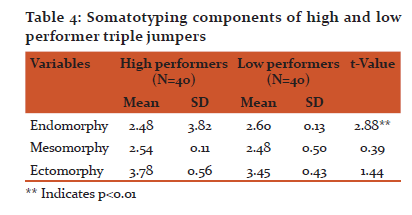IJCRR - 9(11), June, 2017
Pages: 44-47
Date of Publication: 12-Jun-2017
Print Article
Download XML Download PDF
Anthropometric Measurements, Body Composition and Somatotyping among University Level High and Low Performer Triple Jumpers
Author: Karanjit Singh
Category: Healthcare
Abstract:In the present study, the anthropometric measurements, body composition and somatotying components of the triple jumpers (n= 20; 10 high performer and 10 low performer) was studied. The players were all male (18-25 years) triple jumpers participating in the Inter-university Athletic Competition. The height, weight, body lengths, diameters, circumferences and skinfold thicknesses were measured of the subjects. From these variables, the body composition and somatotyping components were calculated. The high performer triple jumpers were significantly taller (p< 0.01) in comparison to the low performer triple jumpers. The high performer triple jumpers also had significantly higher sitting height (p< 0.01), length measurements (p< 0.01), circumferences (p< 0.01) and diameters (p< 0.01) of body parts in comparison to the low performer triple jumpers. The lean body mass (p< 0.05) was also significantly increased in high performer triple jumpers than those of the low performer triple jumpers. The endomorphy component (p< 0.01) on the contrary was higher among the low performer triple jumpers when compared to high performer triple jumpers. Hence, in the present study, the high performer triple jumpers had better anthropometric characteristics and body composition components in comparison to the low performer triple jumpers.
Keywords: Anthropometry, Somatotyping, Triple Jumpers, Percent Body Fat, Lean Body Mass
Full Text:
INTRODUCTION
Sports performance is a phenomenon which is considerably affected by many factors. Although skill, psychological variables as well as capacious energy-production systems are important components of sports performance, the body size, shape and morphology play a remarkable role in various sport performances (Claessens et al., 1994). The earlier studies on athletes reported that mostly the sprinters are muscular, marathoners are smaller and leaner and throwers are taller and heavier with higher levels of fat. Hence morphological parameters therefore might be associated with success in different sports (Norton et al., 1996).
It is a well-established that a relationship exists between morphology and performance. But still there are some lacunae regarding morphological necessities which are required to be assessed for some sports. There exist some contradictions, as Ross et al. (1982) reported individual’s somatotype to be the best component and Carter (1985) stressed on morphological factors being a better component which may affect sport performance. Among athletes, the body size, shape and proportions play an important role in player’s performance and usually stronger the performance, the more strong is the relation (Bell and Rhodes, 1975; Toriola et al., 1987). The studies also report that inappropriate physique affects the sports’ performance strongly (Tanner 1964, Carter 1984).
Physical characteristics are unique for every individual. A very strong variation exists among humans that two individuals differ from each other. In regard to this variation, the sports performance is greatly dependable on specific physique characteristics. Physical components comprising body composition, size, type and structure are therefore important variables influencing performance in various sports events.
Physique signifies the shape, the size and development of an individual. These factors are interrelated and are indices of the internal structure and tissue components which are pretentious by the environmental as well as the genetic factors (Sodhi and Sidhu, 1984). Somatotype analysis is an informative picture of the kinanthropometric characteristics of high level athlete. In this sense, the somatotyping method is believed to be adequate parameters than simple linear anthropometric measurements (Rienzi et al., 1999), as it constitutes adiposity, musculo-skeletal robustness and linearity variables. Hence, the present study aimed at assessment of differences in anthropometric measurements, somatotyping and body composition of university level high and low performer triple jumpers.
METHODOLOGY
University level triple jumpers (n=20) formed the study group. They were selected from Inter-university Athletic competition held at Manonmaniam Sundaranar University Tirunelveli (Tamilnadu). Only the male triple jumpers of age ranging 18 to 25 years were included in the study. On the basis of performance in the athletic competition, the study subjects were classified into two different groups. The high performance group comprised the players those qualified for finals in triple jump event or remained in first ten positions whereas those who could not qualify for the finals or did not qualify for first ten positions were included in low performance group.
Data Collection
The portable weighing machine was used to record the body weight of the subjects. Height and lengths of upper and lower extremities were measured using the standard anthropometric rod. Digital sliding caliper was used to record the widths and diameters of body parts of the subjects. Flexible steel tape was used to measure the circumferences of the body parts of the subjects. Harpenden skinfold caliper was used to measure the skinfold thicknesses of the body parts of the subjects.
Body Composition
Siri (1956) and Durnin and Womersley (1974) equations were used to calculate the percentage body fat from the sum of skinfolds. Body density was calculated using the following regression equations
For 17 to 19 years age group:
Body Density (gm/cc) = 1.1620-0.0630 (X) (Durnin and Womersley, 1974)
For 20 to 29 years age group:
Body Density (gm/cc) = 1.1631-0.0632 (X) (Durnin and Womersley, 1974)
Where X = log (biceps+triceps+Subscapular+suprailliac).
% Body Fat = [4.95/ body density-4.5] ´ 100 (Siri, 1956)
Total Body Fat (kg) = (%body fat/100) ´ body mass (kg)
Lean Body Mass (kg) = body mass (kg) – total body fat (kg)
Somatotyping
Somatotype components (endomorphy, mesomorphy, ectomorphy) were calculated by Carter and Heath (1990) method using the equations given following
Endomorphy = - 0.7182 + 0.1451 (X) - 0.00068 (X2) + 0.0000014 (X3)
where X = (sum of triceps, subscapular and supraspinale skinfolds) multiplied by (170.18/height in cm).
Mesomorphy = 0.858 ´ humerus breadth + 0.601 ´ femur breadth + 0.188 ´ corrected arm girth + 0.161 ´ corrected calf girth – height 0.131 + 4.5.
Where corrected arm girth =flexed arm girth - triceps skinfold/10
corrected calf girth = maximal calf girth - calf skinfold/10.
Ectomorphy = 0.732 HWR - 28.58
Where HWR = height / cube root of weight
If HWR is less than 40.75 but greater than 38.25 then
Ectomorphy = 0.463 HWR - 17.63
If HWR is equal to or less than 38.25 then
Ectomorphy = 0.1
Statistical analysis
SPSS Version 16.0 (Statistical Package for the Social Sciences, version 16.0, SSPS Inc, Chicago, IL, USA) was used for analysis of the data. Data were presented as mean values and standard deviation. Student’s t-test for independent samples was used to compare the means within the groups groups. Significance levels were set at p<0.05.
RESULTS

The descriptive statistics of height, weight, sitting height, BMI and length measurements of high and low performer triple jumpers are presented in Table-1. The results revealed that the high performer triple jumpers were significantly taller (p<0.01) than the low performer triple jumpers. The sitting height (p<0.01) was significantly increased among the high performer triple jumpers as compared to low performer triple jumpers. Also the total leg length (p<0.01), upper leg length (p<0.01) and lower leg lengths (p<0.01) were significantly increased in high performer triple jumpers in comparison to the low performer triple jumpers. The total arm length (p<0.01) and upper arm length (p<0.01) were also observed to be significantly increased among the high performer triple jumpers in comparison to those of the low performer triple jumpers. The body mass index (BMI) and forearm length did not vary between the low and high performer triple jumpers.

The descriptive data on circumferences and diameters of body parts of high and low performer triple jumpers are presented in table-2. The chest (p<0.01), abdominal (p<0.05) and calf (p<0.01) circumferences were significantly elevated in high performer triple jumpers than that in the low performer triple jumpers. Also, he Bicondylar humerus diameter (p<0.01) was significantly more among the high performer triple jumpers in comparison to the low performer triple jumpers. The total biacromial (p<0.01), bi-iliocristal (p<0.01), bicondylar femur (p<0.01) and ankle diameters (p<0.01) were also observed to be significantly increased in high performer triple jumpers than the low performer triple jumpers. The upper arm, forearm and thigh circumferences and wrist diameters did not vary between the low and high performer triple jumpers.


The skinfold thicknesses and body composition components of high and low performer triple jumpers are presented in table 3. The high performer triple jumpers were found to have significantly greater lean body mass (LBM) in comparison to the low performer triple jumpers. However, no significant differences were observed for all the skinfold thicknesses i.e. biceps, triceps, subscapular, supra-iliac and calf and other body composition components between the low and high performer triple jumpers.

The somatotyping components of the high and low performer triple jumpers are presented in table 4. The low performer triple jumpers had significantly higher endomorphy component (p<0.01) as compared to high performer triple jumpers. On the other hand, no significant differences were observed for mesomorphy and ectomorphy components between the low and high performer triple jumpers.
DISCUSSION
The high performer triple jumpers were taller than low performer triple jumpers. As per requirement of the sport, the athletes participating in jumping events such as high jump and triple jump, need to be tall and therefore have long lower limbs (Cureton, 1951; Eiben, 1972; Tanner, 1964). The height and weight of the high performer triple jumpers in the present study is greater than those in Indian jumpers reported by Sodhi (1991). These were comparable with the triple jumpers from Brazil (Guimaraes and De Rose, 1980) and Olympic level jumpers studied by de Garry et al. (1974) and Carter et al. (1982). The high performer triple jumpers have higher circumferences and diameters which signify better growth and development in comparison to low performer triple jumpers. The percentage body fat is lower whereas the lean body mass is higher in high performer triple jumpers compared to the low performers. The excessive fatness in the body seems to be a performance hindrance factor in jumping events whereas lean body mass plays significant role in jumping events where power is required to achieve high performance. The somatotype scores of high performer triple jumpers are 2.4-2.5-3.7 which accord with the somatotyping scores of Olympic level jumpers ranging between 2-5-3 and 2-3-5 reported by Tanner (1964). The triple jumpers of the present study are balanced ectomorph. These findings are supported by other studies (Sodhi, 1991; Guimaraes and De Rose, 1980).
CONCLUSION
Significant differences were observed among high performer and low performer triple jumpers with regard to anthropometric measurements, body composition and somatotyping. The high performer triple jumpers had better anthropometric characteristics and body composition components.
References:
- Bell W, Rhodes G. The Morphological characteristics of the association football player. Brit. J. Sports Med., 1975; 9:195-200.
- Carter JEL, Heath HB. Somatotyping—Development and Application. Cambridge University Press, 1990.
- Carter JEL. Morphological factors limiting human performance. In: Clarke DH. Eckert HM.eds. Limits of Human Performance, American Academic of Physical Education Papers No 18 Human Kinetics Champaing, 1985; 106-117.
- Carter JEL. Physical Structure of Olympic Atheletes Part- I. The Montreal Olympic Anthropological Project. S. Karger, Basel, 16. 1982.
- Carter JEL. Somatotypes of Olympic athletes. From 1948-1976 Med. Sport Science. In : Carter, J.E.L. (eds) Physical Structure of Olympic Athletes, Part – II, Kinanthropometry of Olympic athletes, Karger Basel, 1984; 80-109.
- Claessens AL, Hlatkey S, Lefevre J, Holdhaus H. (1994) The role of anthropometric characteristics in modern pentathlon performance in female athletes. Journal of Sports Sciences, 1994; 12:391-401.
- Cureton TK Jr. Physical Fitness of Champion Athletes. University of Illinois Press, Urbana, 1951.
- De Garay AL, Levine, Carter JEL. Genetic and Anthropological Studies of Olympic Athletes, Academic Press, New York, 1974.
- Durnin JVGA, Womersley J. Body fat assessed from total body density and its estimation from skinfold thickness measurements of 481 men and women aged from 16-72 years. British Journal of Nutrition, 1974; 32:77-97.
- Eiben OG. The Physique of Women Athlete. The Hungarian Scientific Council for Physical Education, Budapest, 1972.
- Guimaraes ACS, De Rose EH. Somatotype of Brazilian student track and field athletes of 1976. Kinanthropometry II Blatimere, University Park Press, 1980; 231-238.
- Norton KI, Olds TS, Olive SL, Craig NP. Anthropometry and sports performance. In: Anthropometrica (edited by Norton, K.I. and Olds, T.S.) Sydney, UNSW Press, 1996; 287-364.
- Rienzi E, Reilly T, Malkin C. Investigation of anthropometric and work-rate profiles of Rugby Sevens players. J. Sports Medicine and Physical Fitness. 1999; 39: (2), 160-164.
- Ross WD, Marfell-jones MJ, Stirling DR. Prospects in Kinanthropometry. In : Jackson JJ. Wenger HA, eds. The Sport Science Physical Education Series:4, University of Victoria, Victoria. 1982; 134–150.
- Siri WE. The gross composition of the body. Advances in Biological and Medical Physics, 1956; 4:256–280.
- Sodhi HS, Sidhu LS. Physique and Selection of Sportsmen. Punjab Publishing House, Patiala, 1984.
- Sodhi HS. Sports Anthropometry (A Kinanthropometric Approach) Anova Publications, Mohali, 1991.
- Tanner JM. The Physique of the Olympic Athletes (Allen and Unwin London), 1964.
- Toriola AL, Adeniran S, Ogunremi RT. Body Composition and anthropometric characteristics of elite male basketball and volleyball players. J Sports Med. Phy. Fitness, 1987; 27:235-239.
|






 This work is licensed under a Creative Commons Attribution-NonCommercial 4.0 International License
This work is licensed under a Creative Commons Attribution-NonCommercial 4.0 International License